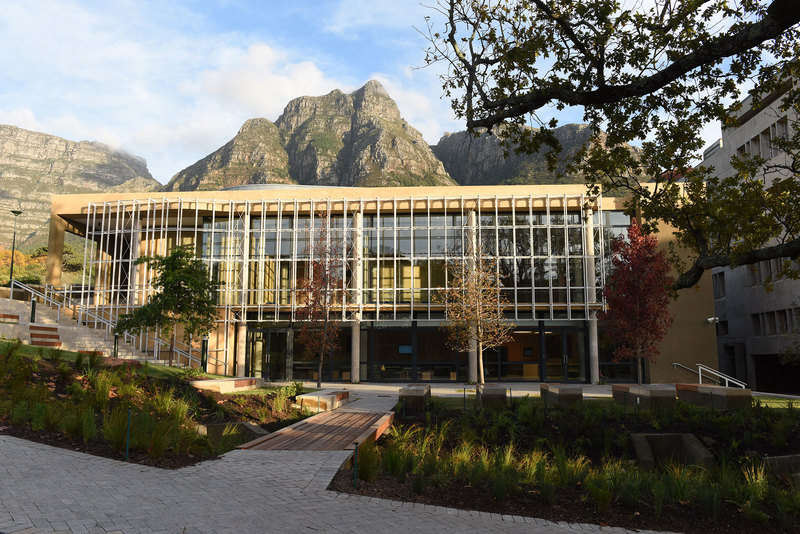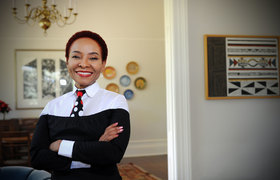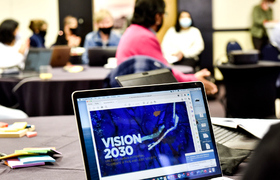How to build the university of the future
02 July 2021 | Story Niémah Davids. Photo UCT News. Read time 8 min.
Universities around the world have been rocked by the COVID-19 pandemic. Phenomena such as online teaching and learning have become the “new normal”, and it has required rapid adaptation from both students and academics. In a post‑pandemic world, will this temporary learning methodology become a permanent facet of the higher education model globally? What will the university of the future look like?
A panel of international academic experts addressed these and other questions during a University of Cape Town (UCT) virtual Summer School lecture on Thursday, 1 July. The lecture, “The university of the future … after the pandemic”, unpacked how universities will need to adapt in a post-pandemic world.
In her welcome address, UCT Vice-Chancellor Professor Mamokgethi Phakeng told the audience that COVID-19 has not been the world’s only disruptive element. Global problems such as climate change, poverty and inequality, gender inequality and gender-based violence are some of the other challenges with which countries around the world are grappling. Therefore, there is an urgent need for change.
“As uncomfortable and disruptive as the pandemic has been, it has forced us to consider higher education from different points of view.”
“As uncomfortable and disruptive as the pandemic has been, it [has] forced us to consider higher education from different points of view. It even [revealed] opportunities that we would not otherwise have seen, or would not otherwise have grabbed if we were comfortable,” she said.
“This is why we are here today – to explore different perspectives and discover new insights about higher education.”
The University of the Future
For a long time, Professor Dan Remenyi – a UCT alumnus who has been involved in the higher education and business sectors for most of his working life – has been pondering what universities of the future will look like. Almost two years ago, he set out to address this question. He spearheaded a project to produce a book based on a selection of papers from academics around the world, and titled it The University of the Future. The book was first published in 2019.
“The book was fine, except for one [thing] – the word ‘COVID-19’ didn’t appear anywhere. So we relaunched a call for chapters, and decided to call the second book The University of the Future: Responding to COVID-19,” he said.
Several issues were raised in both books, including the global university culture in which institutions seem to favour research over education; and a few academics also pointed out that universities are so big in size that no one really understands their complete function and operation.
But the pandemic revealed a host of other challenges.
“No one needs to be reminded about the enormous disruption [caused by COVID-19]. Anything that involved human proximity was hit over the head in a very big way. That puts universities right on the spot,” Remenyi said.
He said academics praised video conferencing, which enabled emergency remote teaching and learning, and “saved the university” at the onset of the pandemic. But they acknowledged that the spirit and complexity of university life will not and cannot be replaced by a video conference link.
Overall, Remenyi said, three key principles emerged from both books:
- Many aspects of the university operation can be improved. There is scope for reform and reimagining how institutions deliver education is important.
- There is a need to review the way universities use technology. Using technology in a range of different ways is possible.
- Forget the importance of bouncing back from the pandemic. Instead, build better and stronger institutions and come back in a different way.
New ways of working
Reimagining smart learning and smart university campuses was the focus of Professor Niyi Awofeso’s discussion. Professor Awofeso works in health administration at Hamdan Bin Mohammed Smart University in the United Arab Emirates.
He said the global COVID-19 vaccine roll-out programme presents a glimmer of light at the end of a very dark tunnel. But in the interim, it’s imperative that universities begin to explore how to “climb ahead” and consider effective, modern ways to operate in the post-COVID-19 era. Discussions on new learning platforms that will provide the main avenue for learning globally should start now.
“Higher education institutions will now have to shift [focus] and become more efficient with regard to what really matters.”
“Higher education institutions will now have to shift [focus] and become more efficient with regard to what really matters. Is it still bricks and mortar? No, I don’t think so,” he said.
According to Awofeso, embracing the concept of ‘smart campuses’ for both new and established institutions is one way to change things up. Smart campuses, he explained, are extensions of smart cities, and will provide new means of attending university. The concept necessitates that the on‑campus experience should be integrated with the digital experience. In addition, embracing a smart learning environment is another way of reimagining universities. Smart learning environments are supported by technology, he said; they make the necessary adaptations for learning, and provide timely and appropriate personalised and contextualised support to students.
“[Students] will have the opportunity to access knowledge using a number of devices – from a mobile phone to a desktop – at any place and time. You can be on holiday and still attend class. That’s one big advantage of what will become the new normal in the post-COVID-19 era,” Awofeso said.
Popular media
Dr Lakshmi Balachandran Nair, an assistant professor (research) in the Department of Business and Management at Luiss Guido Carli University in Rome, Italy, said using popular media in the classroom should be explored as a viable teaching and learning alternative in the university of the future.
The concept uses stories, movies, music, games and television shows to teach students. The strategy helps to ensure good student–teacher engagement, and helps students understand the subject matter and develop the necessary capabilities to interpret and build arguments on the topic.
In her classroom, Dr Balachandran Nair uses stories such as Harry Potter, movies like The Circle and Catch Me If You Can, and television series such as The Good Wife to teach students about ethics. Students are loving it, and their grades prove this, she added.
“Popular media can be used in a learner‑centric manner, and can contribute to building better classrooms in an interesting manner.”
“Popular media can be used in a learner‑centric manner, and can contribute to building better classrooms in an interesting manner. It helps to introduce students to real‑life situations, and prepares them for critical reviewing and tackling social phenomena,” she said.
“I would like to recommend the inclusion of popular media in the classrooms and universities of the future after the pandemic.”
The Honourable Lord David Willets, president of the Resolution Foundation in the United Kingdom, also added his voice to this discussion.
 This work is licensed under a Creative Commons Attribution-NoDerivatives 4.0 International License.
This work is licensed under a Creative Commons Attribution-NoDerivatives 4.0 International License.
Please view the republishing articles page for more information.










